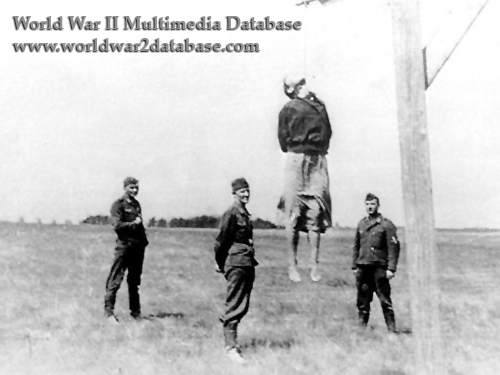| Three German soldiers pose for a photograph with the corpse of a woman identified as a partisan. The Germans preferred hanging to shooting, because the gallows made for a more public spectacle that they believed intimidated the civilian population in occupied territories. Women were especially targeted; some were hung for refusing sex with German soldiers, most for suspected alliances with or actually being partisans. Often the executions were excuses to murder Jews. Many German soldiers took souvenir photos and even sent them back home. Generaloberst Alfred Jodl (May 10, 1890-October 16, 1946) Deputy Chief of the Oberkommando der Wehrmacht (OKW, “Army High Command“) signed the Commissar Order on June 6, 1941. Issued before the start of Operation Barbarossa, Communist party members to be shot when captured. Soviet Premier Josef Stalin called for massive partisan activity behind German lines in his radio broadcast on July 3, 1941. Expecting an easy, quick victory, The Germans were not prepared to deal with a large network of separate partisan groups in their rear areas. With the large encirclement battles of 1941, tens of thousands of Red Army soldiers hid in forests and small villages and towns across the occupied Soviet territories; as the Red Army began to win victories, thousands of men and women joined the partisans. Some 10% of partisans were women. On November 11, 1942, OKW issued their second order on the handling of partisans, “Combat Directive for Anti-Bandit Warfare in the East.“ German soldiers were instructed to ignore “sentimental considerations,“ explicitly told them to execute partisans, anyone who helped them, and specifically singled out women for retribution against partisan activity. XXX Corps announced to the populace that they would kill ten civilians for every German killed by partisans. Other units killed 100 Soviets for an enlisted man and 200 for officers. After Stalingrad in February 1943 the Red Army began to organize and supply partisan units. The Anti-Bandit order was repealed by Jodl on May 6, 1944, as the Red Army was poised to retake all her native territory. Little attention was paid by the German rank and file to either order since Oberkommando des Heeres (OKH) dictated policy on the Eastern Front until April 1945. at his trial on June 4, 1946, Jodl responded to the prosecution‘s assertion that the partisan war was a cover for the killing of Jews and Slavs: “The fight against partisans was a horrible reality. In July 1943, to quote some figures, 1,560 instances of railway sabotage occurred in Russia. There were 2,600 in September; that is 90 per day. A book by Ponomarenko [Soviet Partisan General Panteleimon Ponomarenko] was published from which an American paper quoted 500,000 Germans as having been killed by the partisans. If a nought is crossed off from that figure, it is still quite a considerable achievement for a peaceful Soviet population. But the book is also said to have stated that the population became increasingly hostile; that murder and terror became more frequent; and that the peaceful Quisling mayors were being killed. At any rate it was a tremendous fight which was taking place in the East.“ Jodl was convicted of war crimes and executed by hanging on October 16, 1946. Date Estimated. | |
| Image Filename | wwii0235.jpg |
| Image Size | 107.50 KB |
| Image Dimensions | 500 x 375 |
| Photographer | Unknown |
| Photographer Title | |
| Caption Author | Jason McDonald |
| Date Photographed | January 01, 1942 |
| Location | |
| City | |
| State or Province | |
| Country | Soviet Union |
| Archive | |
| Record Number | |
| Status | Caption ©2009, ©2024 MFA Productions LLC Please Do Not Duplicate or Distribute Without Permission |

Author of the World War II Multimedia Database

